The NVIDIA SHIELD Android TV Review: A Premium 4K Set Top Box
by Ganesh T S on May 28, 2015 3:00 PM EST- Posted in
- Media Streamer
- Home Theater
- TV
- 4K
- Shield
- NVIDIA
System Performance
From an editorial perspective, the SHIELD Android TV may be one of the most frustrating devices we’ve worked on in recent history. Simply put, the Android TV market is still a tiny market. Google’s Nexus Player is most of the market right now, and only very recently have other Android TV devices such as the Forge TV and SHIELD Android TV reached the market.
As a result, figuring out what to compare the SHIELD Android TV to and how to present it has been an interesting challenge. A set top box is not a mobile device, and while they share similar OSes and the same families of SoCs, that does not make them identical devices. At the same time however, if we restrict ourselves to just Android TV devices, it would be a very limited and uninteresting comparison. The Nexus Player is a quad-core Intel Atom, but only includes 1GB of RAM, among other limitations.
Ultimately it’s clear that the SHIELD Android TV is heavily overspeced compared to other Android TV devices – no one else is pursuing this premium market – so instead we’re going to focus on looking at benchmarked performance relative to the newest generation of SoCs in the latest iOS and Android tablets. This is by no means a fair matchup and we need to be clear about this – the SHIELD Android TV has no throttling or power constraints, no need to balance out energy efficiency – but it at least gives us some idea of how the device and Tegra X1 compare to other products. Just don’t expect to see a Tegra X1 tablet perform this well. And in the meantime, some of the results may surprise you.
As always for an Android device review, we'll start off with our browser benchmarks. SHIELD Android TV doesn’t actually ship with a browser – we had to sideload Chrome – but these are among our most flexible benchmarks and help put performance in context of more than just Android devices.
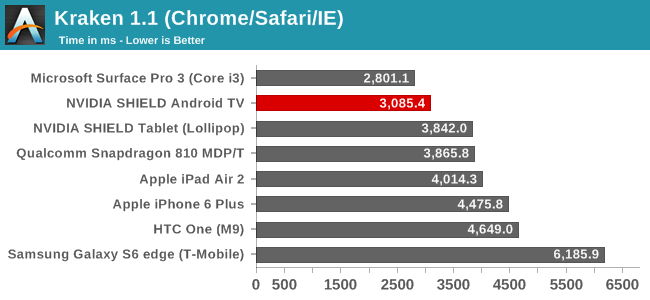
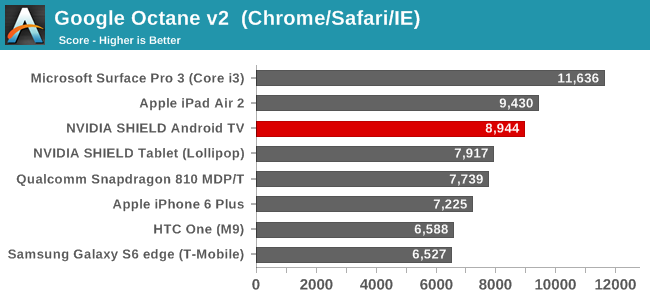
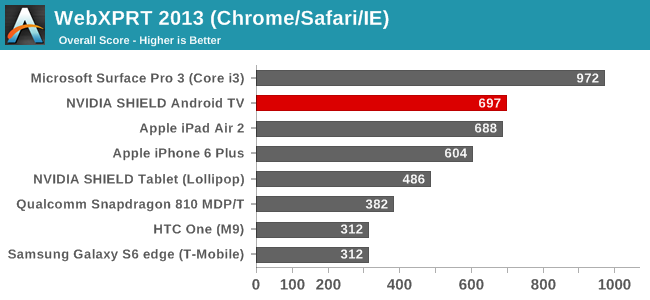
Among Android devices, the SHIELD Android TV stands alone, as you’d expect. Without any throttling to hold it back, it leads over Tegra K1, Snapdragon S810, and Exynos 7420 over all 3 web benchmarks. That said, even with its unrestricted Cortex-A57 CPU cores, we also find that Apple’s A8X-based iPad Air 2 is a close match in Octane and WebXPRT, just edging out the SHIELD Android TV and being edged out respectively. Meanwhile for anyone curious how this compares to high-end x86 tablets like the Surface Pro 3, well even SHIELD Android TV isn’t quite up to par with those devices at this time.
Moving on, we have Basemark OS II 2.0, which should give a better picture of CPU performance in addition to overall device performance.
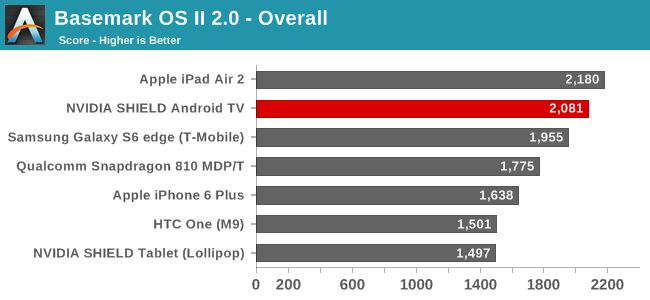

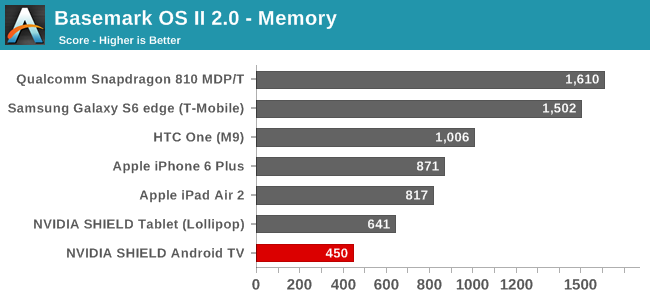
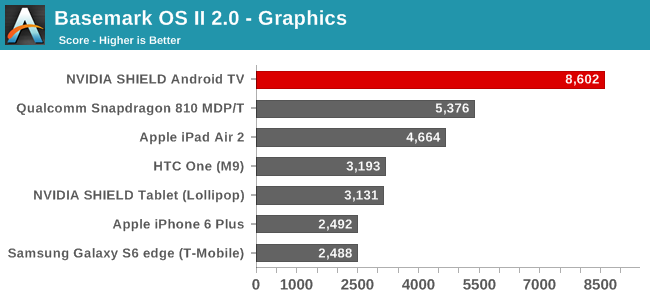
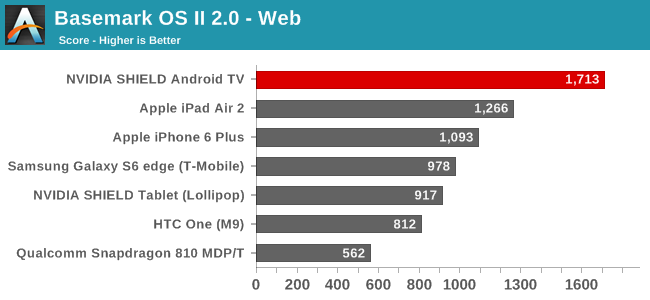
Overall, performance under Basemark still slightly favors the iPad Air 2. SHIELD Android TV easily takes the second spot, but it’s not enough to catch Apple’s tablet.
Looking at the subscores, we can see why this is. SHIELD Android TV only fares decently under the System test, but not well. The big surprise here is not the iPad, which always does well, but the fact that the SHIELD is so far behind the Galaxy S6, which features a similar CPU setup. As this sub-test pushes both the CPU and memory, we may be seeing something related to the implementation differences between Tegra X1 and Exynos 7420, or it may just be an Android TV-inspired difference.
However the memory score is particularly bad, coming in behind even the last-generation SHIELD Tablet. As this is a NAND test, what we're likely seeing is a consequence of the SHIELD's poor random performance, something we'll dive into a bit later in our detailed look at NAND performance.
On the other hand, graphics and web performance are outstanding. We had certainly expected the SHIELD to do well in graphics given what Maxwell is capable of – it is a graphics monster unlike any other current SoC – but the web test is a pleasant surprise. The combination of using Android TV’s built-in web view and the lack of any real throttling likely play a big part here, and although Android TV doesn’t ship with a standard web browser, this bodes well for any apps making use of web view and Javascript.
Our next system benchmark is PCMark, which does a number of basic benchmarks designed to stress various aspects of the device in everyday workloads like video playback, web browsing, text editing, and photo editing. This tends to test every aspect of a mobile device, unlike microbenchmarks that can often miss aspects of the system that can affect performance.
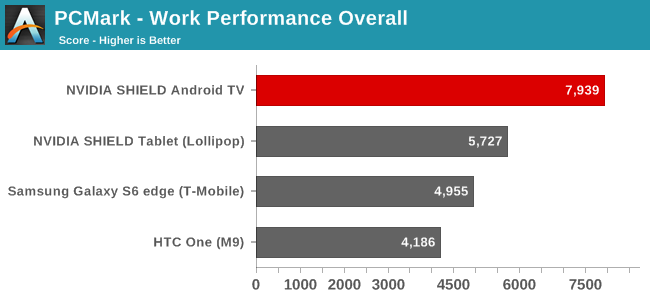
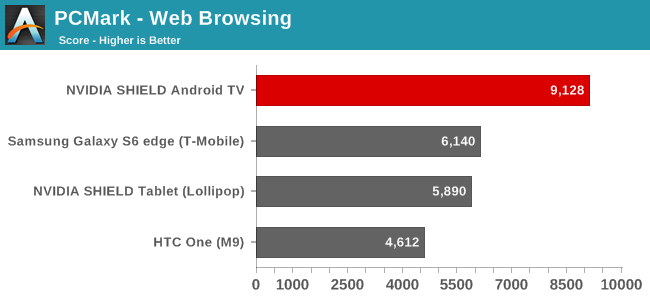

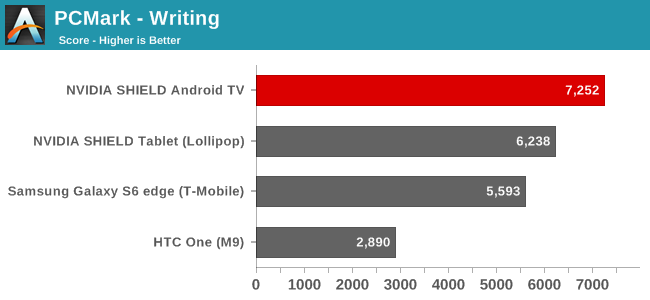
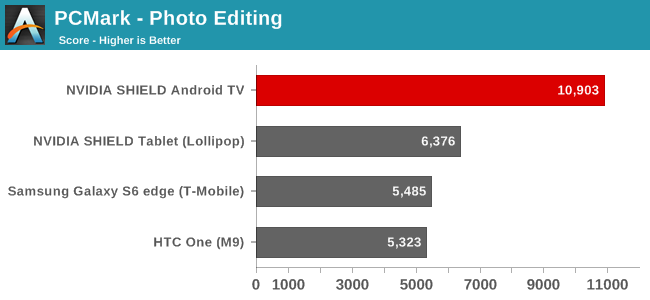
With the exception of the Writing subtest, where the SHIELD Android TV and second-place device are kind of close, PCMark is a runaway victory for the SHIELD Android TV. Once again we’re almost certainly seeing the benefits of the box’s aggressive performance since it doesn’t need to throttle down, or even be conservative on clockspeeds for power purposes. In which case it gives us an interesting look at what Cortex-A57 can do when not held back.
Overall, CPU/system performance is more or less what one would expect based on the design of the SHIELD. As a set top box with a quad-core A57 implementation under the hood and the cooling to let it run wild, SHEILD is frequently A57 at its best. Which means it’s going to easily surpass other A57 devices in most situations, but it also means that even with its unrestricted performance, Apple’s A8X processor and its tri-core “Enhanced Cyclone” CPUs still serve as a reminder of those times where A57 struggles against Enhanced Cyclone’s high-IPC design.
For our final look at system performance, let’s take a quick look at the SHIELD's built-in NAND performance with AndroBench 4.0.
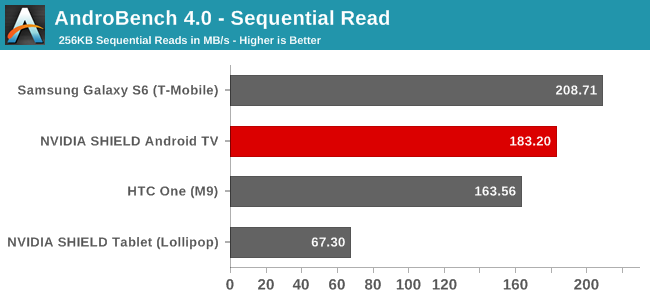
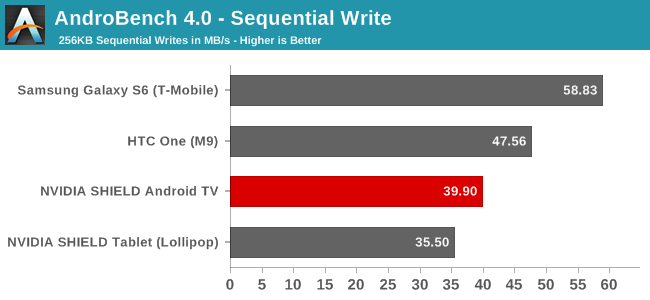
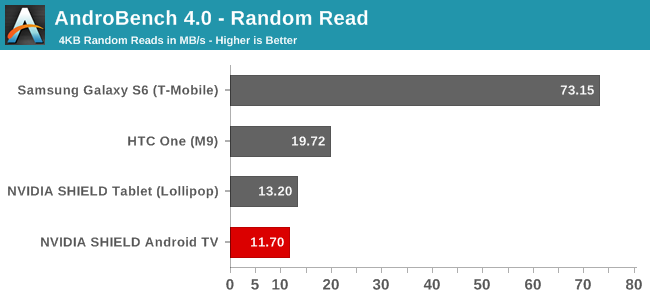
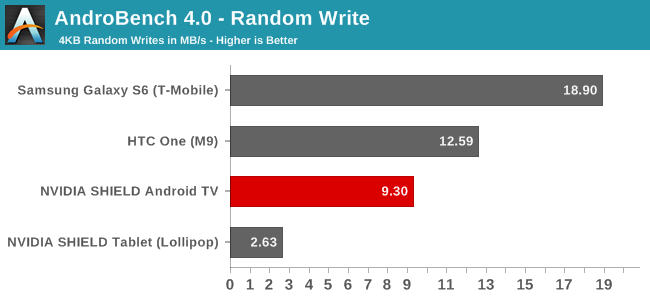
Update 5/28: AndroBench numbers have been revised to account for an error, sorry about that
Though we only have a few AndroBench 4.0 results compiled so far, it’s enough to paint a decent picture. For sequential reads the SHIELD’s built-in NAND fares relatively well. It’s not enough to top the Galaxy S6 and its UFS flash, but it’s keeping up with the pack. Sequential writes on the other hand aren't quite as good, with write performance ahead of only the SHIELD Tablet. Meanwhile random performance is a real mixed bag; the SHIELD Android TV is at the bottom of the random read chart - below even the SHIELD Tablet - while random write performnace is significantly better than the tablet, but still chasing the M9 and well off the S6.
Among Android flagship devices UFS definitely gives the Galaxy a big benefit here, but the SHIELD could stand to improve all the same. However I’m not sure how much that matters to NVIDIA, as the SHIELD is clearly designed to lean on external storage via microSD/USB for users who end up using it for storage-intensive needs such as gaming as opposed to basic set top box streaming.










167 Comments
View All Comments
nandnandnand - Thursday, May 28, 2015 - link
What is 24p? 24-bit audio?piroroadkill - Thursday, May 28, 2015 - link
I'm pretty sure he's referring to native 24 Hz output, or more than likely, 23.976, as most content (such as the video on Blu-ray discs) is encoded at 23.976.hifiaudio2 - Thursday, May 28, 2015 - link
Really too bad about no lossless audio codec support. Maybe a codec licensing pack add on for $20 or something?SleepModezZ - Thursday, May 28, 2015 - link
They say it supports FLAC. It is lossless and should support different sampling rates and bit rates. It is free. Maybe Ganesh refers to some other proprietary format that SHIELD TV is lacking?ganeshts - Thursday, May 28, 2015 - link
I was referring to lossless HD audio - like the type of tracks in BD-Audio discs or even certain Blu-ray soundtracks. - DTS-HD MA and TrueHD - [ http://forum.blu-ray.com/showthread.php?t=91776 ]SleepModezZ - Thursday, May 28, 2015 - link
Thank you. Are those codecs widely used outside of Blu-ray discs? As the SHIELD is not a Blu-ray player, those codecs are only important if they are used in streaming services. Unfortunately I don't know what Netflix or other services uses.ganeshts - Thursday, May 28, 2015 - link
I believe using the SHIELD as a player for the Blu-ray rips on a NAS will be a common use-case.SleepModezZ - Thursday, May 28, 2015 - link
Ok. Then the question is, is it possible to transcode DTS-HD soundtracks to multichannel FLAC streams while ripping the Blu-ray disc, and if, what do you lose in the conversion? FLAC (and HDMI) can handle up till 8 channels high res audio. Is there some problem with the AV receiver understanding such streams? If not, it would be recommended to rip Blu-ray discs into a format that SHIELD TV can play back. Re-encoding old rips should not be too difficult - just takes some time and electricity.ganeshts - Thursday, May 28, 2015 - link
AFAIK, there is no open source DTS-HD MA decoder.In any case, the easiest ripping scheme is to extract tracks without any transcoding. If the end-player can't support the resulting rip, then it is not something ideal - After all, there are probably other players which do support it.
In the case of the SHIELD, the only thing unique about it from a video playback perspective is support for 4Kp60 HEVC decode and HDMI 2.0 / HDCP 2.2 for 4K Netflix. If either of those are important to you right away, then you will be very happy with the SHIELD Android TV. If they are not urgent requirements - the only aspect preventing me from whole-heartedly recommending the SHIELD Android TV is that it is a closed embedded platform unlike a PC. We need something open and extensible like a HTPC that will also have full HEVC decode and HDMI 2.0 / HDCP 2.2
SleepModezZ - Thursday, May 28, 2015 - link
Thank you for your patience. It seems you are right - there is only commercial software for decoding dts-hd, so a free program like Handbrake can only pass-through the soundtrack, and then SHIELD can't play it.